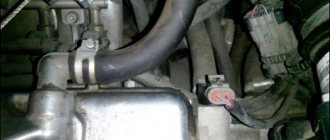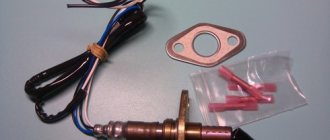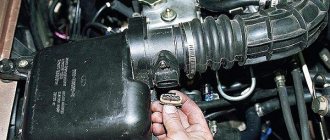Malfunctions of the throttle sensor lead to unstable operation of the car engine. That the TPS is not working correctly can be understood by the following signs: unstable idle, decreased car dynamics, increased fuel consumption and other similar troubles. The main sign that the throttle position sensor is faulty is jumping speed. And the main reason for this is wear on the contact tracks of the throttle valve sensor. However, there are a number of others.
Checking the throttle position sensor is quite simple, and even a novice car enthusiast can do it. To do this, you only need an electronic multimeter capable of measuring DC voltage. If a sensor fails, repairing it is most often impossible, and the device is simply replaced with a new one.
Signs of a malfunctioning throttle position sensor
Before moving on to describing the symptoms of a TPS failure, it makes sense to briefly dwell on the question of what the throttle position sensor affects. It is necessary to understand that the main function of this sensor is to determine the angle at which the damper is rotated. The ignition timing, fuel consumption, engine power, and dynamic characteristics of the car depend on this. Information from the sensor enters the electronic engine control unit, and based on it, the computer sends commands about the amount of fuel supplied and the ignition timing, which contributes to the formation of an optimal air-fuel mixture.
Accordingly, malfunctions of the throttle position sensor are expressed in the following external signs:
- Unstable, “floating” idle speed.
- The engine stalls while changing gears, or after changing from any gear to neutral speed.
- The engine may stall randomly when idling.
- While driving there are “dips” and jerks, in particular during acceleration.
- The engine power is noticeably reduced, and the dynamic characteristics of the car drop. This is very noticeable in terms of acceleration dynamics, problems when driving the car uphill, and/or when it is heavily loaded or towing a trailer.
- The Check Engine light on the dashboard activates (lights up). When scanning errors from the ECU memory, the diagnostic tool shows error p0120 or another related to the throttle position sensor and its malfunction.
- In some cases, there is increased fuel consumption by the car.
It is worth noting here that the signs listed above may also indicate problems with other engine components, in particular, a malfunction of the throttle valve. However, during the diagnostic process, it makes sense to also check the TPS sensor.
Conclusion
A TPS failure is a serious situation for a car. This device is responsible for supplying fuel to the engine and, if malfunctioning, can lead to a critical situation. If signs of failure are detected, it is advisable to replace the sensor, but in some cases, repairs can solve the problem faster and cheaper. Follow the procedure and use only original spare parts.
Diagnostics and repair of the throttle position sensor
This article will discuss the design of the throttle position sensor, diagnostics and symptoms of TPS , as well as its repair.
Throttle position sensor device
So, if you are wondering how the throttle position sensor works, then you should first consider the principle of its operation.
The throttle position sensor is a resistive type sensor. This name determines the principle of its operation, namely, if we disassemble this sensor, then inside we will find a moving element in the form of a slider that slides along a track in the form of an arc or horseshoe. A supply voltage is supplied to one end of this track, the other end of the track is connected to ground, and the output signal is removed from the movable slider.
Throttle Position Sensor Malfunction:
What malfunctions of the throttle position sensor are most often encountered in practice? If we ignore the faults associated with frayed wires leading to the sensor, etc. then we can highlight the main and most common malfunction of sensors of this type, namely wear of the resistive layer on the tracks along which the slider slides. As a rule, wear is observed in the initial section of the slider movement due to the most frequent use of this section. If you have disassembled the throttle sensor, then in most cases the wear of the resistive layer will be noticeable during a visual inspection, as in the photo presented.
The sensor is supplied with a 5V from the car's ECU, however, when measuring the voltage, you will see that the voltage on the sensor varies from 0.3-0.5 V in one position and up to 3.7-4.8 V in the fully open throttle position. This is done so that the ECU can identify a malfunction in the sensor circuit, be it a short circuit or an open circuit.
Some car models may use throttle position sensors with an inverse output characteristic , that is, the voltage when the throttle is closed will be maximum, and as the throttle opens it will drop.
It should also be noted that on cars where the throttle position is set using an electric drive (popularly known as an “electronic pedal”) in these models, the throttle position is determined using not one, but two potentiometers , which are combined in one device . It does not matter whether the electronic pedal sets the position only in idle mode or throughout the entire range. One of the two potentiometers has an inverse output characteristic, and the second has a direct output characteristic. On such systems, you can also find a micro-limit switch that is activated the moment the accelerator pedal is completely released by the driver.
How to detect a malfunction of the throttle position sensor without disassembling the sensor and removing it from the car:
– a malfunction of the throttle position sensor can be easily determined using a scanner , motor tester or a simple multimeter . In this article we will look at an example of detecting a fault using a scanner.
Please note that all devices except the motor tester will not be able to detect a malfunction in the form of wear of the resistive layer except for very strong and extended sections, because As a rule, only a motor tester manages to display the diagram in the correct form; the scanner, due to the low speed of exchange with the ECU, will not be able to detect short-term damaged areas that occupy a space of tenths of a second in the diagram.
So, go to the real-time parameter reading mode in the scanner, then go to the section that takes readings of the throttle position as a percentage or voltage on the sensor, then start slowly opening the throttle and monitor the output signals from the scanner.
It is most convenient to take these readings in oscillogram mode, if, of course, your scanner supports this function. Data from the sensor should grow slowly without jumps or sharp drops. If the signal increase has sharp dips or increases, this indicates wear of the resistive layer on the sensor tracks.
Causes of TPS malfunction
There are two types of throttle position sensors - contact (film-resistive) and non-contact (magnetoresistive). Most often, it is the contact sensors that fail. Their work is based on the movement of a special slider along resistive tracks. Over time, they wear out, which is why the sensor begins to provide incorrect information to the ECU. So, the reasons for the failure of a film-resistive sensor may be:
- Loss of contact on the slider. This can be caused either simply by physical wear or by a broken tip. The resistive layer may simply wear out, causing the electrical contact to also disappear.
- The linear voltage at the sensor output does not increase. This situation may be caused by the fact that the base coating has worn off almost to the base in the place where the slider begins to move.
- Wear of the slider drive gears.
- Broken sensor wires. These can be both power and signal wires.
- A short circuit has occurred in the electrical and/or signal circuit of the throttle position sensor.
As for magnetoresistive sensors , they do not have a coating of resistive tracks, so their breakdowns are mainly reduced to broken wires or a short circuit in their circuit . And the testing methods for one and the other type of sensor are similar.
In any case, repairing a failed sensor is hardly possible, so after performing the diagnostics, you simply need to replace it with a new one. In this case, it is advisable to use a non-contact throttle position sensor, since such a unit has a much longer service life, although it is more expensive.
Checking the performance of the TPS
The throttle sensor is usually checked with a multimeter in dial mode. They simulate the operation of the valve, then monitor voltage surges on the device scale in sound control mode. If wheezing is heard, the potentiometer definitely needs to be replaced.
Checking the sensor operation with a multimeter
Read more about how inspections are done at car services:
Next, the test is carried out using special equipment through the built-in OBD II system.
ODB II System Diagnostic Tester
Computer diagnostics makes it possible to obtain error codes, after studying which specialists judge the specific causes of the malfunction.
Only after this is a new throttle sensor installed, since without analyzing the complete picture of the unit’s operation, it is risky to do anything.
Here, for example, is some error data with decoding: p0120 - malfunction of the throttle position sensor circuit and p2135 - discrepancy in TPS readings. Also, problems with the potentiometer are indicated by errors under the numbers: p0122, p0123, p0220, p0222, p0223. As for wiring damage, this usually occurs due to poor quality materials. This applies in particular to isolation. After installing a new regulator, the error information is necessarily erased from the memory of the control unit. Usually, to do this, it is enough to disconnect the battery, wait about 15 minutes, then put the negative terminal in place.
Specialists are able to identify malfunctions of the throttle sensor also by the operation of the accelerator pedal. If during acceleration you feel dips and the car jerks strongly. Or the engine vibrates, but the gas is released.
How to Determine a Malfunctioning Throttle Sensor
Checking the TPS itself is simple, and all you need is an electronic multimeter capable of measuring DC voltage. So, to check the TPS malfunction, you need to follow the algorithm below:
- Turn on the car's ignition.
- Disconnect the chip from the sensor contacts and use a multimeter to make sure that the sensor is receiving power. If there is power, continue checking. Otherwise, it is necessary to “ring” the supply wires in order to find the break point or another reason why the voltage to the sensor is not suitable.
- Set the negative probe of the multimeter to ground, and the positive probe to the output contact of the sensor, from which information goes to the electronic control unit.
- When the throttle is closed (corresponds to the accelerator pedal being fully depressed), the voltage at the sensor output contact should not exceed 0.7 Volts. If you open the throttle completely (fully depress the accelerator pedal), then the corresponding value should be at least 4 Volts.
- Next, you need to manually open the damper (rotate the sector) and at the same time monitor the multimeter readings. They should rise smoothly. If the corresponding value rises abruptly, this indicates that there are worn spots in the resistive tracks, and such a sensor must be replaced with a new one.
Replacing TPS
- Removing the sensor from the car is necessary to install a new one. First of all, you need to turn off the electrical power by disconnecting the battery terminals. The wires that are connected to the device also need to be disconnected. After unscrewing the mounting bolts, the TPS can be removed. When installing a new, original spare part, no adjustment is required.
- Direct installation of a new device. To begin with, the spare part is connected to the electronic control unit, after which the terminal is put on the battery. With this algorithm of actions, all factory settings will be saved. Attention: it is important to install only original devices. A sensor from another car model is not suitable. The necessary device can be purchased in special stores or from an official representative of the car brand. Buying online or on the market most often leads to the acquisition of counterfeit goods. The choice of seller should be taken carefully and seriously.
Purpose of the PDZ sensor
The throttle position sensor is designed to transmit information about the state of the bypass valve at a specific period to the vehicle engine ECU. This mechanism is a combination of a fixed and variable resistor.
In total, the maximum resistance of the device is approximately 8 ohms. The TPS device includes 3 contacts. A voltage of about 5 V is supplied to 1 and 2, contact 3 is a signal contact and is connected to a specific controller.
The PD sensor is mounted on the throttle body and reacts to its opening or closing. The resistance of the device also changes:
- with the throttle valve fully open, the voltage value at the signal contact will be at least 4 V;
- with a completely closed remote control - up to 0.7 V.
Any voltage changes are regulated by the controller. The volume of fuel required to create the air-fuel mixture is adjusted accordingly.
It should be noted that a breakdown of the PDZ sensor is often the cause of incorrect operation of the gearbox. Repairing a car engine and gearbox is a rather labor-intensive and costly undertaking. Therefore, if signs of malfunction of the throttle sensor are detected, it is recommended to check the functionality of the gearbox.
Additionally, we recommend reading our specialist’s article on how to check the mass air flow sensor.
We also recommend reading our expert’s article, which talks about what a crankshaft position sensor is.
You may also be interested in an article by our specialist, from which you can learn how the idle speed sensor works.
How to troubleshoot
The throttle potentiometer cannot be repaired. If it is damaged, a new element should be installed. However, in some situations partial recovery is possible:
It is advisable to install expensive contactless sensors. Their price is higher, but they are distinguished by increased reliability and long service life.
New throttle sensor
Main signs of device malfunction
Problems in operation can be identified by the following signs of a malfunction of the TPS, indicating a breakdown of this particular mechanism:
- Regardless of the operating mode of the engine, the idle speed is not constant.
- If you suddenly release the gas pedal, the engine stalls when you change the gearbox.
- Motor power drops significantly.
- When the engine is idling, the speed is not constant.
- Fuel consumption has increased noticeably.
- Despite the smooth depressing of the gas pedal, jerking is noticeable when accelerating.
In some situations, the Check Engine indicator light may come on, but it will not go out for some period. This signal should also not be neglected: it is imperative to check and eliminate errors in the operation of the device.
Regarding the identification of throttle valve malfunctions, the symptoms of which were identified during the operation of the car, there is a certain algorithm of actions:
- The first thing you need to do is turn off the ignition, inspect the instrument panel, notice whether the Check Engine indicator light is on or not, which signals the presence of problems. If the indicator does not light up, you need to climb under the hood and check the TPS.
- Next, you will need a multimeter - a special device to check the operation of the throttle sensor.
- It is necessary to determine the presence of a “minus”. In order not to discard each wire separately, it is worth piercing the necessary wires and measuring them.
- The search for “mass” is carried out in the same way. There is no need to turn on the ignition during the mechanism check period.
The purpose of performing preliminary actions is to check the availability of power to the PD sensor. The voltage depends on the make of the car. For example, for some machines it may be only 5 V, while for other models it may be 12 V.
Algorithm of actions for identifying TPS faults, the symptoms of which were identified while the vehicle was moving:
- you need to turn on the ignition and pierce the wires of the required chain one by one using a multimeter. The device display should show a voltage reading of 0.7 V;
- the throttle valve opens manually: the voltage value must be greater than 4 V;
- The ignition is turned off, one connector is discarded. In the area between the slider terminal and the wire (which remains), a multimeter probe is connected;
- Now you need to manually scroll the sector and observe the readings of the measuring device. If there is a smooth increase in values without sudden jumps, it means that the PD sensor is working normally. In the opposite situation, we can talk about damage (scuffing) of the resistor track.
For example, the throttle valve is fully open, but the electronic device shows that it is closed. If such symptoms are present, this is an obvious malfunction of the throttle sensor and must be replaced.
Checking TPS
If the car shows one or more signs of malfunction, you need to check the sensor. This process does not require special skills: it is enough to have a multimeter and follow a certain sequence of actions.
First of all, you need to turn off the ignition. Check to see if the Check Engine light is on. If it goes out, then you can open the hood and inspect the TPS. To do this, you need a multimeter with which readings will be taken.
If the TPS is faulty, it requires replacement. In addition, you need to do several checks to prevent future breakdowns. It is advisable to completely replace the sensor - a low cost will allow the engine to operate fully. Problems for which it is recommended to replace the sensor:
After replacing the TPS with a new one, no additional configuration is required. By default, it considers idling to be zero.
Reasons for sensor failure
It is impossible to completely prevent breakdowns of units, parts, and electronic mechanisms of vehicles.
Possible reasons for failure of the TPS:
- Loss of contact between the slider and the resistive layer. The reason is that the tip is broken, causing scoring on the substrate. The throttle sensor may continue to function (not correctly) until the resistive layer is completely erased. As a result, the core fails completely.
- A linear increase in the voltage of the output signal is not provided due to a violation of the base deposition at the start of the slider stroke.
Owners of VAZ-2110 cars often have to repair their vehicle. And the consequence of repair work can be both significant breakdowns and minor malfunctions. What type of failure is a malfunction of the throttle position sensor? What is this part responsible for in a car? How can we determine that this particular part is no longer functioning correctly? Read about it in our article.
Sensor types
There are several types of TPS, but there are only two main differences. The conventional throttle position sensor, used by all car manufacturers, has resistive tracks and a slider in its design. Such a regulator is rigidly fixed to the pipe of the air supply system and connected to the axle. The shutter opens when the driver presses the gas, which naturally turns the axis and moves the slider.
Non-contact sensors are produced as an alternative to the contact potentiometer. Devices operate due to dynamic changes in the magnetic field. The slider here does not directly contact the working part, everything is tied to the electronic component.
Non-contact TPS
Such regulators are less likely to break down, but are noticeably more expensive.
Read more about the types of potentiometers in the table.
Ways to improve reliability
possibility of installing 2 backup sensors
What is TPS in a VAZ-2110 car?
The throttle position sensor is abbreviated as TPS among motorists. This part is used in several types of engines:
- Gasoline injection type.
- Single injection type.
- Diesel engines.
TPS is also known as a throttle valve potentiometer. This is due to the fact that the sensor is designed to function as a variable resistor. The sensor itself is installed in the engine compartment - the place of fixation is the throttle pipe. The mechanism of operation of the sensor is as follows: depending on the position and degree of opening of the throttle valve, the resistance also changes. That is, the level of the value of such resistance depends on the pressing of the gas pedal. If the pedal is not pressed, the throttle valve will be closed and the resistance will be minimal. The opposite is true when the damper is open. Accordingly, the voltage across the TPS, which is directly proportional to the resistance, will also change.
The control of such changes is carried out by the electronic control system; it is the one that receives all signals from the TPS and supplies fuel using the fuel system.
So, at the maximum voltage of the signal contact of the throttle position sensor, the fuel system of the VAZ-2110 car will supply the largest portion of fuel.
Cleaning Rules
Before removing and cleaning the throttle valve, you need to buy a special cleaner for it. There are many manufacturers, there is enough choice. Among the inexpensive ones, Abro is effective.
Disassembly:
You need to remove the engine cover (decorative plastic); Reduce the pressure in the cooling system by unscrewing the expansion tank cap; Loosen the clamps and remove the hose from the forced ventilation air pipe; Use a screwdriver to remove the heating hoses for the remote control (it is advisable to plug them for now); Disconnect the cable and unscrew the fastening nuts. Now removal of the throttle assembly is possible; Use a cleaner to wash everything very thoroughly. Most often, it is necessary to use a needle to check whether the forced ventilation channel is coked, and also to clean it; Cleaning is necessary for the idle air regulator, for which it must be removed and inspected. If you find that it is jamming and adjustment is impossible, then it needs replacement; After washing, reassemble everything as it was
Please make sure that the gasket is intact and in good condition, then you can leave it. If this is not the case, then only replacement.
Communication of the throttle valve with other automotive systems of the VAZ-2110
The throttle valve of a VAZ-2110 car is a component of the engine intake system and is directly connected to a large number of other vehicle systems. These include the following systems:
- directional stability;
- anti-blocking;
- anti-slip;
- anti-slip;
- cruise control.
In addition, there are those systems that are controlled by the electronics of the gearbox. After all, it is this throttle valve that regulates the flow of air into the car system and is responsible for the quality composition of the fuel-air mixture.
TPS design
The throttle position sensor can be of two types:
- film;
- magnetic or contactless.
In its design, it resembles an air valve - in the open position the pressure corresponds to atmospheric pressure, in the closed position it drops to a vacuum state. The TPS includes DC and AC resistors (each resistance is 8 ohms). The process of opening and closing the damper is monitored by the controller, with subsequent adjustment of the fuel supply.
If at least one symptom of a malfunction occurs in the functioning system of this sensor, then fuel may be supplied to the engine either in excess or in deficiency. Such malfunctions in engine operation are reflected in the engine of the VAZ-2110 car and on its gearbox.
Correction of a factory miscalculation
It is quite common for a throttle assembly to come out of the factory with something that cannot even be called a defect, but can still be attributed to design errors. In theory, air should flow into the space behind the throttle, for which a channel of approximately 2.5 mm is specially made.
But the whole problem is that this channel was pressed against the wall of the receiver, thus blocking the possibility of air flow. A slight modification of the throttle assembly can help in this case.
Bored channel for air flow in the throttle
To do this, just take a file and use it to make a small groove in the indicated place. 2 - 3 mm will be enough. But before doing this, it is necessary to remove the throttle.
On a VAZ 2110, the throttle assembly is removed in the following sequence:
- Disconnect the connectors of the sensor that regulates the position of the throttle valve, its drive cable and the XX regulator;
- We partially drain the coolant;
- Next is the removal of the air hose located on the body of the mass air flow sensor. Why do you just need to loosen the clamp;
- We also loosen the clamps: where the throttle pipe is attached to the air hose; where the hose of the 2nd crankcase exhaust circuit is attached to the cylinder head cover pipe. We remove the connected hoses - the air and 2nd crankcase ventilation circuits;
- Having loosened the clamp, remove the hose of the 1st crankcase gas exhaust circuit from the throttle assembly fitting;
- Having loosened the clamps, we remove the hoses supplying and discharging coolant;
- You will need a wrench with a 13mm head, with which you need to unscrew the nuts securing the throttle assembly to the receiver on a VAZ 2110;
- It is now possible to remove the throttle assembly from the studs;
- It remains to remove the sealing gasket and, if your VAZ 2110 has a system that traps gasoline vapors, disconnect the hose for purging the adsorber.
Even if the purpose of removing the throttle was to modify it, still do not forget that for stable operation it also needs periodic cleaning
There is, frankly, nothing complicated in this procedure, but it will help the engine perform better, which is quite important
For cleaning you will need:
- short and long screwdrivers;
- toothbrush (soft, or just old);
- cotton buds;
- cleaning agent;
- rubber or cotton gloves.
For cleaning to give the desired result, it must be carried out very carefully. First, you can go through all the cavities with a toothbrush, at the same time cleaning the idle speed control (it must also be removed). Further, more delicate, cleaning is done with cotton swabs
Pay special attention to the area where the throttle valve is located and the place where the XX regulator fits.
Please note that cleaning the crankcase ventilation duct with conventional means is not possible, but it can be easily done using the foot pump available in each trunk. The diameter of the fitting is similar to the wheel one, you just need to add cleaning agent and pump your foot several times.
If you have problems mentioned at the beginning that started recently, cleaning should fix them. If there were problems from the beginning, do not forget about improvements. Sometimes only replacing the throttle assembly helps.
Characteristic symptoms of a malfunctioning TPS condition
Thanks to the correct functioning of the throttle position sensor, the fuel system of the VAZ-2110 car engine works with a smoothing effect. That is, the vehicle moves smoothly, and the gas pedal responds well to pressure. Therefore, a malfunction of the TPS can be noticed almost immediately by the following signs:
- Poor engine starting.
- Noticeable increase in fuel consumption.
- The car's movements are intermittent.
- The idle speed of the engine is noticeable when running.
- The Check e light comes on on the dashboard
- The car accelerates poorly due to delays in acceleration.
- Popping sounds are heard in the intake manifold.
Of course, these signs of a faulty sensor may not all be observed at once. But even if you notice only one of the above symptoms, it is worth carrying out computer diagnostics of the vehicle at a service center.
Cleaning the remote control
If these signs appear, it is recommended to clean the throttle valve on the VAZ 2110. To carry out this operation, special auto chemicals are used. The most commonly used product is to clean carburetors.
Cleaning the throttle body will cost much less than buying a new throttle body for a VAZ 2110. The price of a new unit is several times higher.
To clean the throttle unit with your own hands, you must use the following materials and tools:
- screwdriver;
- set of tools with keys and heads;
- new throttle body gasket;
- protective gloves;
- carburetor cleaner;
- ear sticks for hard-to-reach places;
- old toothbrush.
The procedure for cleaning the throttle valve on a VAZ 2110:
1. Raise the hood of the car. Remove the terminals from the battery. It is enough to throw off the negative terminal. To do this, we use a key set to 10. 2. Dismantle the receiver. Loosen the clamps on the 5 pipes. We remove the pipes. Four pipes are visible from above, the fifth is located under the throttle valve assembly. 3. Disconnect the connectors from the sensor on the throttle valve and the idle air control (IAC). 4. Disconnect the throttle control cable. 5. Unscrew the throttle block from the receiver with a key. 6. Using a screwdriver, unscrew the idle speed control crosswise. We remove the IAC from the throttle block. 7. Using a cleaning product, an old toothbrush and ear sticks, we clean the throttle unit
We pay special attention to the channels and landing sites of the IAC. Remove carbon deposits and dig
Before using a special carburetor cleaner, you can wash the unit with plain gasoline. 8. It is recommended to apply lubricant to the idle speed control rod. To do this, we use silicone grease, which will help extend the service life of the IAC and the throttle unit as a whole. 9. Assemble the throttle assembly. We screw it to the receiver, not forgetting to install a new gasket. We connect all pipes and connectors.
An important part of the throttle valve is the “nickle”. Some car enthusiasts bore out the chamber of the assembly and install a “penny” of increased diameter
This can achieve a more enriched combustible mixture. Motor power increases. It is better to entrust the engine tuning operation to a motor specialist. You should not carry out such an operation on your own, without good preparation.
Another reason for unstable behavior of an internal combustion engine may be a faulty throttle sensor. On a VAZ 2110, you can replace the sensor yourself. Its price is low. It is recommended to use a non-contact sensor. Its cost is slightly higher, but the sensor will last significantly longer.
You can diagnose the sensor yourself. For this you need a tester. Let's look at it step by step:
- The ignition must be turned on. We measure the voltage between the potentiometer contact and the “minus”. The correct value on the voltmeter is 0.7 Volts.
- We turn the plastic sector to the limit, thereby opening the damper completely. The voltmeter should show 4 Volts.
- The ignition should be turned off, disconnect the connector from the sensor and measure the resistance of the potentiometer of the remote sensing sensor.
- We smoothly turn the sector and observe the tester readings. If the sensor is working properly, the needle will move without jerking and smoothly. If this is not the case, then the throttle sensor should be replaced.
If cleaning and replacing the idle speed sensor does not solve the problem of smooth running, you need to contact a motor mechanic; it may be necessary to conduct additional engine diagnostics or adjust the idle speed control. This operation is carried out using special devices.
TPS problems and their diagnosis
As you know, eternal parts for cars have not yet been invented. And the breakdown of the TPS can be foreseen; for this you need to inquire about the possible reasons for the failure of this part. Here are the main ones:
- Abrasion of the sprayed base layer, which serves to move the slider (the result is incorrect TPS readings).
- Failure of the movable type core (the result is deterioration of the contacts between the slider and the resistive layer).
How can you figure out problems with this sensor yourself? To do this, you can independently diagnose the operation of your diagnostics:
- Listen to the VAZ-2110 engine idling:
- the breakdown is obvious if you notice that its speed is in a “floating” state;
- Quickly release the gas pedal:
- a malfunction is present if the engine stops after this action.
- Pick up speed:
- There is a problem with the TPS if the car starts to move jerkily, which indicates an incorrect supply of fuel to the system.
Experts say that most often the sensor fails when the resistive track is heavily contaminated or is completely broken. To verify the opposite, you need to check the working condition of the TPS.
Tuning by replacement
The standard valve (throttle assembly) usually has a diameter of 46 millimeters; many fans of various tunings decide to replace this part with an alternative one:
- VAZ 2112 throttle valve 52 has a larger diameter (there are also valves of 54 and 56 millimeters)
- Is there any benefit from such tuning?
- In various online stores they often offer to replace the standard 46 mm throttle body (DU) and install 52, 54 or 56 mm
- The product description says that an enlarged throttle body (also known as the throttle body) leads to a decrease in air flow speed, which improves the performance of the air intake system
- The effect of installing an alternative damper will be clearly visible when using a zero-resistance filter in the system
- We recommend installing a unit with a diameter of 52mm, because... the diameter of its air inlet for a standard receiver is 53mm
The valve is standard (standard) on the left and new (increased flow diameter) on the right
- In order to install a remote control of a different diameter, as a rule, nothing needs to be modified
- The maximum necessary action is a small trimming of the gasket (this is most often necessary when installing a 56mm throttle assembly)
The following positive effects are noticed after such an installation:
- The car becomes more agile
- Problems with idle speed disappear
- The gas pedal also becomes more responsive.
Installation disadvantages:
- Fuel consumption increases, although many believe that the BC gives incorrect readings and consumption does not change
- Some owners see the effect exclusively on 16-valve engines
The picture we described above may appear completely different:
- All the positive effect that many people notice when installing a larger diameter remote control usually appears because the old remote control already needed cleaning and naturally the motor was not working correctly
- After installing a (clean) new remote control, the engine starts working in its normal mode, this seems like a “new breath”
- In other words, all the described effects appear after regular cleaning of the remote control.
- And besides this, after replacing the remote control, with a larger diameter you will have new problems with the operation of the motor that did not exist before
- This is due to a violation of the ratio of gasoline and air, which the ECU is no longer able to correct.
- And instead of simply returning the remote control to the standard diameter, the owners are recommended to replace the firmware, the price of which is higher, but there is no point
- There is also an opinion that a remote control with a diameter of 52, 54 or 56 millimeters is a completely useless thing, and only installed in combination with other engine tunings produces a noticeable effect
- It remains unclear whether this effect is caused by remote control or other modifications to the engine
- After all, if on a turbo engine with a power of no more than 200 horsepower, standard 46mm dampers are left and their work is quite enough











